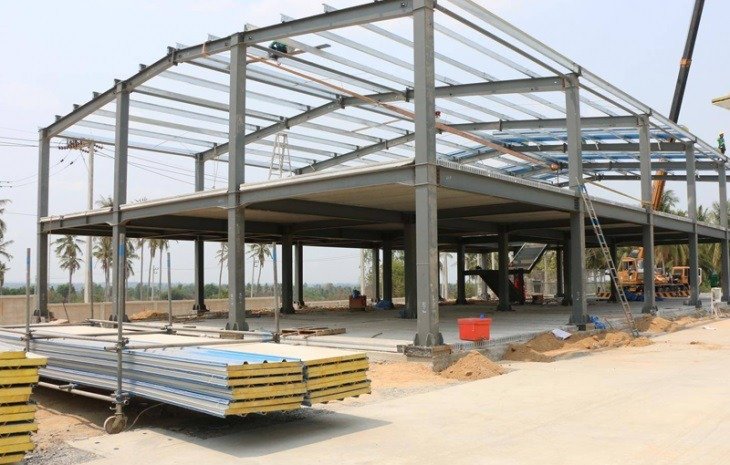In the world of construction, Pre-Engineered Buildings (PEBs) have gained significant popularity in recent years. PEBs are pre-designed and fabricated structures that offer numerous advantages in terms of cost-effectiveness, speed of construction, flexibility, and durability. This article explores the benefits and applications of PEBs, shedding light on why they have become a preferred choice for various construction projects.

Advantages of Pre-Engineered Buildings (PEB)
- Cost-Effectiveness
One of the primary advantages of PEBs is their cost-effectiveness. PEBs are designed and engineered in a controlled environment, allowing for efficient use of materials and reduction in waste. The manufacturing process optimizes the use of steel, resulting in significant cost savings. Additionally, the pre-engineered components are easy to assemble, reducing labor costs and construction time. The cost-effectiveness of PEBs makes them an attractive option for both commercial and industrial projects.
- Speed of Construction
Time is a critical factor in any construction project, and PEBs excel in this aspect. The prefabricated components of PEBs are manufactured off-site, allowing for simultaneous groundwork and fabrication. Once the components are ready, they can be quickly transported to the construction site and assembled with ease. Compared to conventional construction methods, PEBs can be erected in a fraction of the time, reducing project timelines significantly.
- Flexibility and Customization
PEBs offer a high degree of flexibility and customization options. The design and engineering of PEBs can be tailored to specific requirements, ensuring that the building meets the exact needs of the client. Whether it’s the size, shape, or layout, PEBs can be easily modified and expanded. The flexible nature of PEBs makes them suitable for a wide range of applications, from warehouses and factories to offices and recreational facilities.
- Durability and Strength
Steel, the primary material used in PEBs, provides excellent strength and durability. PEBs are designed to withstand harsh weather conditions, seismic activities, and heavy loads. The structural integrity of PEBs ensures long-term reliability and reduces the need for frequent repairs and maintenance. Additionally, steel is a non-combustible material, making PEBs resistant to fire hazards. The durability and strength of PEBs make them a secure and long-lasting construction solution.
- Energy Efficiency
PEBs are known for their energy-efficient features. The insulation systems used in PEBs minimize heat transfer, reducing the energy required for cooling and heating. This translates into lower energy costs and a smaller carbon footprint. Additionally, PEBs can be designed to incorporate natural lighting and ventilation, further reducing the reliance on artificial lighting and HVAC systems. The energy efficiency of PEBs aligns with sustainable construction practices and contributes to environmental conservation.

Applications of Pre-Engineered Buildings (PEB)
- Industrial Buildings: PEBs are widely used in the construction of industrial facilities such as warehouses, manufacturing plants, and distribution centers. The large open spaces and high ceilings provided by PEBs allow for efficient storage, material handling, and workflow optimization.
- Commercial Buildings: PEBs have found applications in the construction of commercial buildings such as shopping malls, retail outlets, and office complexes. The flexibility of PEBs allows for versatile layouts and quick construction, meeting the fast-paced demands of commercial projects.
- Institutional Buildings: PEBs are also suitable for institutional buildings like schools, hospitals, and community centers. The customizable design of PEBs enables the incorporation of specialized features, ensuring that the buildings meet the specific needs of the institutions.
- Sports Facilities: PEBs are an excellent choice for sports facilities, including indoor stadiums, gymnasiums, and sports complexes. The open and spacious nature of PEBs allows for the construction of large arenas with unobstructed views and ample seating capacity. The quick construction time of PEBs is particularly advantageous for sports facilities, as they can be ready for use in a shorter timeframe.
- Agricultural Structures: PEBs are increasingly used in agricultural construction, including barns, storage facilities, and animal shelters. The durability of PEBs makes them ideal for protecting livestock, crops, and equipment from the elements. The open layout of PEBs also allows for easy movement of machinery and livestock within the structure.
- Aviation Hangars: PEBs are well-suited for aviation-related structures such as aircraft hangars. The clear span capabilities of PEBs provide ample space for parking and maintaining aircraft. The speed of construction is particularly beneficial for airports and private airfields that require quick and efficient expansion of their hangar facilities.
- Cold Storage Facilities: PEBs are an excellent choice for cold storage facilities and warehouses. The insulation systems used in PEBs help maintain a controlled environment, keeping perishable goods at the required temperature. The large, uninterrupted interior spaces allow for efficient storage and retrieval of goods.
- Recreational Facilities: PEBs are increasingly being used in the construction of recreational facilities like indoor sports courts, swimming pools, and fitness centers. The versatility of PEBs allows for customized layouts to accommodate various recreational activities. The quick construction time ensures that these facilities can be operational sooner, meeting the demand for recreational spaces.

Conclusion
Pre-Engineered Buildings (PEBs) have revolutionized the construction industry with their numerous advantages and diverse applications. The cost-effectiveness, speed of construction, flexibility, durability, energy efficiency, and strength of PEBs make them a compelling choice for a wide range of projects. From industrial and commercial buildings to institutional structures, sports facilities, and agricultural constructions, PEBs have proven their effectiveness and versatility.
As the demand for efficient and sustainable construction solutions continues to grow, PEBs are expected to play an even more significant role in shaping the future of the construction industry. With advancements in design and technology, PEBs will continue to offer innovative solutions that meet the evolving needs of modern construction projects.
Whether it’s the need for quick construction, cost-effective solutions, or customized designs, PEBs provide an attractive alternative to traditional construction methods. As the construction industry embraces the benefits of PEBs, we can expect to see more innovative applications and advancements in this field, further solidifying PEBs as a preferred choice for construction projects around the world.


